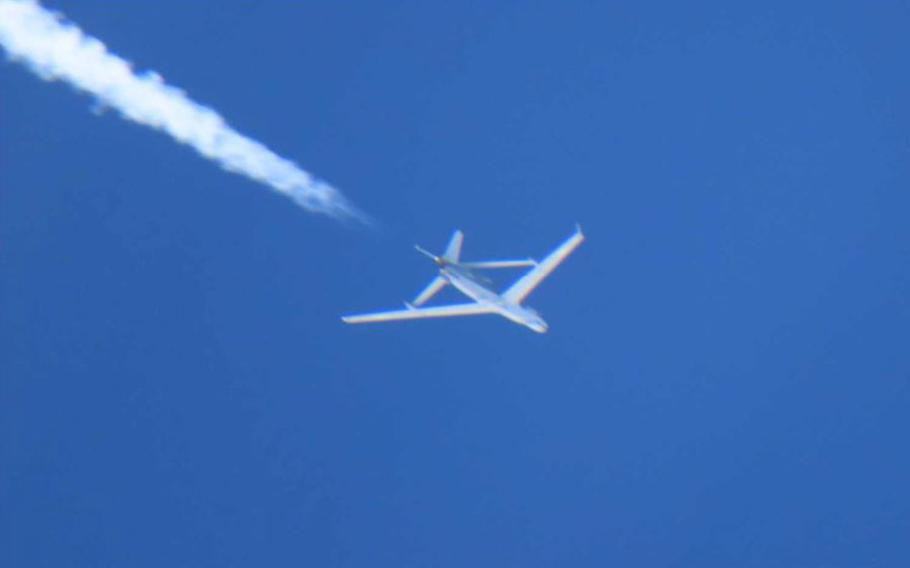
China's WZ-7 Soaring Eagle surveillance drone is an advanced intelligence, surveillance and reconnaissance drone with capabilities comparable to the U.S.-made RQ-4 Global Hawk. (Japan Joint Staff)
TOKYO — Japanese fighters have scrambled for the first time to intercept Chinese WZ-7 Soaring Eagle surveillance drones operating earlier this week near Okinawa, according to Japan’s military.
Japan’s Self-Defense Forces on Sunday and Monday sighted the drones over the East China Sea, where Japan, Taiwan and China have competing territorial claims, according to statements from the Joint Staff on both days.
Japan launched fighters to intercept the drones on both occasions, marking the first scrambles against the WZ-7, according to the Joint Staff. The Soaring Eagle is an advanced intelligence, surveillance and reconnaissance drone with capabilities comparable to the U.S.-made RQ-4 Global Hawk, which flies up to 60,000 feet.
The WZ-7 has an estimated range of 4,350 miles and a service ceiling of 60,000 feet, according to a Nov. 18 report on the Frontier India technology website.
A WZ-7 passed from the East China Sea through the Miyako Strait between Okinawa and the Miyako Islands on Sunday. The drone flew south of Japan’s Sakishima Islands before heading back toward Okinawa, according to a Joint Staff statement Sunday.
The Japan Air Self-Defense Force scrambled fighters in response, the Joint Staff said.
Japan’s military did not say which type of fighters were scrambled.
The next day, another WZ-7 flew a similar path from the East China Sea to the Philippine Sea, passing near Okinawa and other Japanese islands, according to a Joint Staff statement Monday.
The Chinese drones have plenty of unmanned company in the skies over the Far East. Japan and the U.S. Air Force fly Global Hawks from bases in Japan. The Air Force has also been flying MQ-9 Reaper drones from Kyushu, the southernmost of Japan’s four main islands, since November. U.S. Navy MQ-4C Triton drones have also operated from Misawa Air Base and Marine Corps Air Station Iwakuni in recent years.
The Chinese drone intercepts followed a Dec. 21 incident, reported Thursday by U.S. Indo-Pacific Command, in which a Chinese J-11 fighter maneuvered within about 10 feet of a U.S. RC-135 Rivet Joint reconnaissance plane’s wing over the South China Sea.
Also Sunday, the Chinese aircraft carrier Liaoning and its task force of destroyers, a frigate and combat support ship passed through the Miyako Strait into the East China Sea, according to another Joint Staff statement Monday.
From Wednesday to Saturday the carrier made around 20 fighter launches and recoveries and 40 helicopter takeoffs and landings. Japanese fighters also scrambled in response to the air exercises, according to the statement.
The carrier conducted around 320 fighter and helicopter takeoffs and landings Dec. 17-31, the statement said.
Another Chinese carrier, Shandong, has conducted drills in the South China Sea recently, according to a Dec. 24 tweet of satellite images from the region by open-source intelligence analyst Damien Symon.